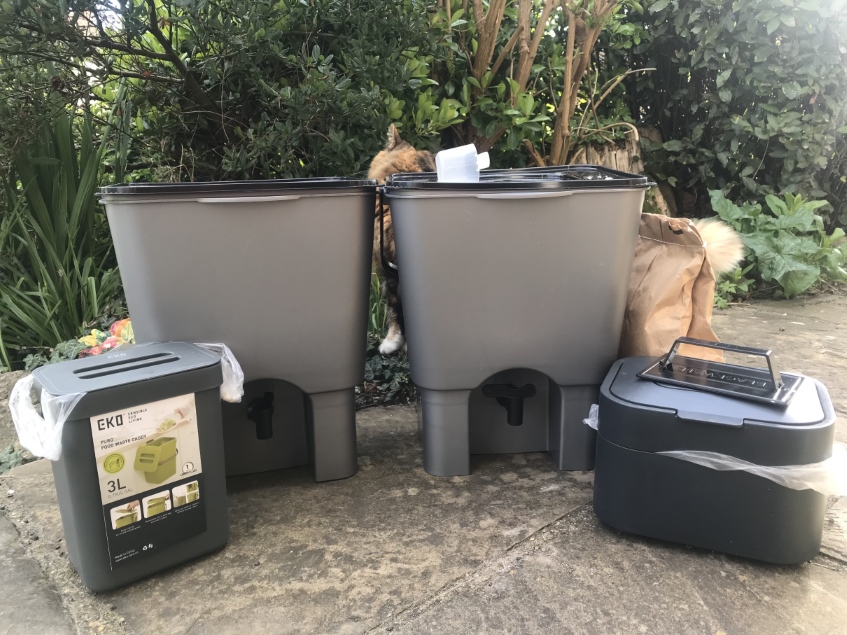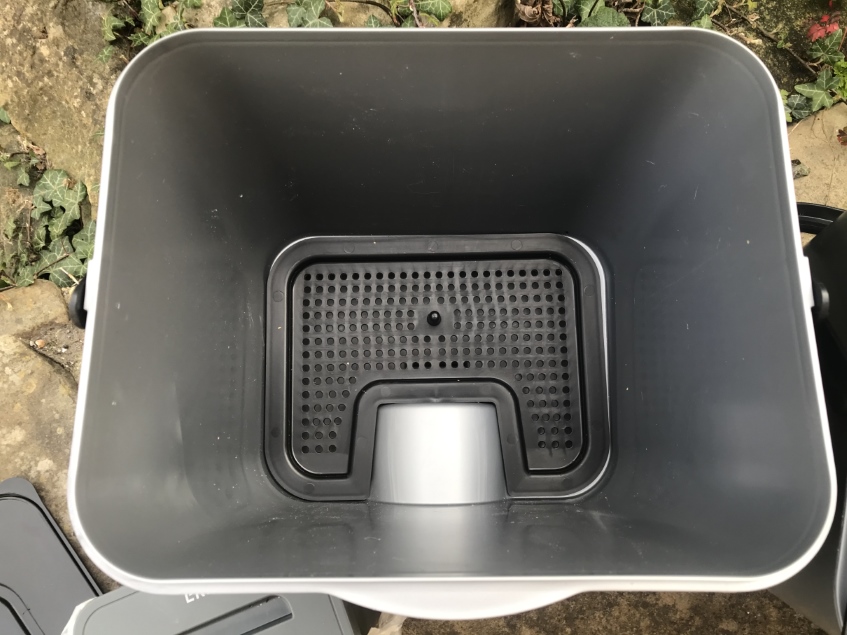My Bokashi bins have arrived, so I’m all set to begin my adventures with composting.
Even with the best of intentions, when you’re feeding a family, throwing food away can be very hard to avoid, and the guilt can weigh heavy. I’ve been hoping (and asking) that our local council begin to collect food waste, but it doesn’t look like that’s going to happen any time soon. Meanwhile, I’ve found plenty of excuses not to begin composting myself: Will it attract vermin? Will it smell bad? Help, I just don’t know where to start.
But help finally arrived when I was put in touch with David Herson, a waste prevention expert and long time composter. Through the medium of Zoom, David gave me a whistle-stop tour of composting and the confidence and motivation to give it a go.
The challenge
Kitchen waste can be divided into two groups:
- Group A – food that can be thrown in a conventional compost bin, such as raw fruit and vegetables, nut shells, tea bags, coffee grounds, houseplants, hair and fur (the last two aren’t food, but with pets in the house they do appear in my kitchen waste)
- Group B – food that can’t, such as cooked food, dairy products, fats, meat and fish bones (the bits that smell bad and can attract vermin and flies )
Aiming for zero food waste, I needed to find a use for both types of waste, without alienating my family and neighbours through yet more unwelcome smells and pests. There are a range of solutions for dealing with foods in Group B, including Green Cones, Green Johannas, HotBins and Wormeries. I liked the idea of a Wormery but wasn’t sure that I wanted to take full responsibility for so many tiny pets, feeling anxious that they might suffer the same fate as my neglected houseplants. Instead I decided to try Bokashi, a process that converts food waste into lovely organic compost, so that:
- the food is fermented by specialist bacteria – this is important because fermenting food smells much better than decomposing/rotting food
- the process is anaerobic (requires no air) so it is carried out in airtight containers (more good news for sensitive noses)
- it works well at room temperature
- the fermented food can be fed directly into the soil after just a few weeks
- virtually all the carbon, energy and nutrients go straight into the soil, without heat or greenhouse gases being released into the atmosphere
- the process also produces a liquid feed, full of beneficial microbes, which can be diluted and used as plant food
This ticked lots of boxes for me and abruptly ended my compost procrastination, but there were still more decisions to be made.
Dual composting systems
Zero waste doesn’t mean zero cost. You need Bokashi bran to start the fermenting process, which retails at about £5 per kg. You can put almost all your food waste into a Bokashi bin, apart from teabags, and I get through more teabags than Mrs Doyle (allegedly). I came to the conclusion that if I was going to succeed at zero food waste, I would need to introduce, not one, but two composting systems. This seemed very over-confident for me, so I decided to order my Bokashi bins before I found any excuses not to. And now they have arrived, so here is the plan:

Stage One: In the kitchen, I have two small food waste bins to collect food waste as it occurs. One for group A food (on the left in the picture above) and one for group B food. I chose a carbon-filter bin for the group B food (on the right). Having these pre-composting bins means I don’t have to keep disturbing the fermentation in the Bokashi bin and, because they are so small, they fit neatly on a work surface, or by the sink.
Stage Two: Also in the kitchen, I have two Bokashi bins. At the end of each day I can empty my collected Group B food into a Bokashi bin. When the first bin is full, I can start filling the second bin. By the time the second bin is full, the first bin should have finished its fermenting process. I can then either add it directly to my soil, or add it to a traditional green compost bin. The Bokashi bins have taps at the bottom, so I can drain liquid plant food at any time after about a week of fermenting.
Stage Three: This is currently hypothetical, but I may, or may not, have a traditional garden compost bin that I can add garden cuttings and group A food waste directly into. I have asked for one for my birthday, so here’s hoping.
See part two of my composting adventures here.
Do you compost, or are you thinking about composting?
- Are you using Bokashi Bins, a wormery, a Green Johanna or something else?
- Have you tips or comments for beginners like me?
- Can you share your composting stories with others here?
Tips, comments and questions welcomed. Use the comments field on this blog, add your own blog post, or email Jill.Shacklock@gmail.com and I’ll post your comments/questions here.
Further information
To buy: Bokashi Bins from Evengreener.com – two for £24.99. this page also provides more information on the Bokashi system. Update: thanks to our roaring inflation, the price has gone up by £10, see Blackwall Twin Pack Bokashi Bin | Food Waste | EvenGreener
Information on Green Cones, Green Johannas, HotBins and Wormeries
Get composting.com – composting resources at reduced prices, negotiated for local councils.
“Beginner’s Guide to Bokashi” video:


Will follow your progress with interest – especially to see how your dog copes with all the exciting new Bokashi liquid smells in your garden!
Great I have a traditional green plastic (sorry) compost bin. It is slow and hard to turn the compost. I will be very interested to see how it goes.